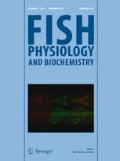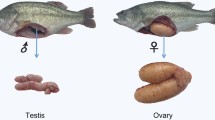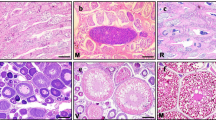Abstract
Pearlscale angelfish Centropyge vrolikii is a kind of protogynous hermaphrodite fish with a natural sexual reversion. Under appropriate social conditions, a female fish can transform into a male fish spontaneously. It is an important prerequisite for artificial breeding to understand the process of its gonadal development and sexual reversion. Gonadal development is regulated by many sex-related genes. In this study, we used unreferenced RNA-Seq technology to sequence the ovary at the perinucleolus stage (OII), ovary at the yolk vesicle stage (OIV),IV and testis (T), respectively; screened the gonadal differential expression genes (DEGs); and analyzed the expression of these genes in different developmental stages of ovary and different sex gonads. The results showed that a total of 142,589 all-unigene samples were assembled, and gene annotation was performed by COG, GO, KEGG, KOG, Pfam, Swissprot, eggNOG, and NR functional database. Comparative analysis revealed that there were 1919 genes that were up-regulated and 1289 genes were down-regulated in comparison to OIV vs OII, while there were 3653 genes that were up-regulated and 2874 genes were down-regulated in comparison of OIV vs T, there were 3345 genes that were up-regulated and 2995 genes were down-regulated in comparison of the OII vs the T. At the same time, the results verified by RT-qPCR were consistent with the variation trend of transcriptome data. Among the results, amh, sox9b, dmrt1, dmrt2, cyp11a, cyp17a, and cyp19a were significantly expressed in the testes, while sox3, sox4, sox11, sox17, and hsd3b7 were significantly expressed in the ovaries. And, the expression of the amh, sox9b, dmrt2, and dmrt1 were low in the OII and OIV, while significantly increased during the ovotestis in the hermaphroditic period (OT), and finally reached the highest level in pure testis after sex reversal. The expression of sox3, sox4, hsd3b7, sox11, and sox17 was significantly reduced during the hermaphroditic period (OT). These results suggested that these genes may play an important role in the process of sex reversal. This study is helpful to further understand the molecular regulation mechanism of gonadal development and sexual reversion in Pearlscale angelfish and also provide important clues for future studies.












Similar content being viewed by others
Data availability
BioSample accessions: SAMN17817928, SAMN17817929, SAMN17817930, SAMN17817931, SAMN17817932, SAMN17817933, SAMN17817934, SAMN17817935, SAMN17817936 Temporary SubmissionID: SUB9037523. Release date: 2022–02-01, or with the release of linked data, https://www.ncbi.nlm.nih.gov/biosample/17817929, https://www.ncbi.nlm.nih.gov/biosample/17817929, https://www.ncbi.nlm.nih.gov/biosample/17817930, https://www.ncbi.nlm.nih.gov/biosample/17817931, https://www.ncbi.nlm.nih.gov/biosample/17817932, https://www.ncbi.nlm.nih.gov/biosample/17817933, https://www.ncbi.nlm.nih.gov/biosample/17817934, https://www.ncbi.nlm.nih.gov/biosample/17817935, https://www.ncbi.nlm.nih.gov/biosample/17817936.
Code availability
Not applicable.
References
Abou-Seedo FS, Dadzie S, Al-Kanaan KA (2003) Sexuality, sex change and maturation patterns in the yellowfin seabream, Acanthopagrus latus (Teleostei : Sparidae) (Houttuyn, 1782). J Appl Ichthyol 19(2):65–73. https://doi.org/10.1046/j.1439-0426.2003.00355.x
Altschul SF, Madden TL, Schaffer AA, Zhang JH, Zhang Z, Miller W, Lipman DJ (1997) Gapped BLAST and PSI BLAST: a new generation of protein database search programs. FASEB Journal, 25(17): 3389–3402. http://blast.ncbi.nlm.nih.gov/Blast.cgi
Bar I, Cummins S, Elizur A (2016) Transcriptome analysis reveals differentially expressed genes associated with germ cell and gonad development in the southern bluefin tuna (Thunnus maccoyii). BMC Genomics 17:217. https://doi.org/10.1186/s12864-016-2397-8
Barros NHC, de Souza AA, Peebles EB, Chellappa S (2017) Dynamics of sex reversal in the marbled swamp eel (Synbranchus marmoratus Bloch 1795), a diandric hermaphrodite from Marechal Dutra reservoir northeastern Brazil. Journal of Applied Ichthyology 33(3) 443 449https://doi.org/10.1111/jai.13273
Casas L, Saenz-Agudelo P, Irigoien X (2020) High-throughput sequencing and linkage mapping of a clownfish genome provide insights on the distribution of molecular players involved in sex change. Sci Rep 8:4073. https://doi.org/10.1038/s41598-018-22282-0
Chan STH, Phillips JG (2010) The structure of the gonad during natural sex reversal in Monopterus albus (Pisces: Teleostei). J Zool 151(1):129–141. https://doi.org/10.1111/j.1469-7998.1967.tb02868.x
Chang CF, Lee MF, Chen GR (1994) Estradiol-17β associated with the sex reversal in protandrous black porgy, Acanthopagrus schlegeli. J Exp Zool 268(1):53–58. https://doi.org/10.1002/jez.1402680107
Chao QH, Shen FF, Xue YD, Wu JK, Zhang JL (2020) Cbx2, a PcG family gene, plays a regulatory role in medaka gonadal development. Int J Mol Sci 21(4):1288. https://doi.org/10.3390/ijms21041288
Chatzifotis S, Muje P, Pavlidis M, Agren J, Paalavuo M, Molsa H (2004) Evolution of tissue composition and serum metabolites during gonadal development in the common dentex (Dentex dentex). Aquaculture 236(1–4):557–573. https://doi.org/10.1016/j.aquaculture.2003.12.004
Chen CY, Tsai YJ, Chang CF (2019a) The roles of cyp19ala and dmrt1 during gonadal sex differentiation and sex change in orange-spotted grouper, Epinepheluscoioides. J Mar Sci Technol 27(3):282–291. https://doi.org/10.6119/JMST.201906_27(3).0011
Chen J, Xiao L, Peng C, Ye ZF, Wang DD, Yang YQ, Zhang HF, Zhao M, Li SS, Lin HR, Zhang Y (2019b) Socially controlled male-to-female sex reversal in the protogynous orange-spotted grouper, Epinephelus coioides. J Fish Biol 94(3):414–421. https://doi.org/10.1111/jfb.13911
Devlin RH, Nagahama Y (2002) Sex determination and sex differentiation in fish: an overview of genetic, physiological, and environmental influences. Aquaculture 208(3–4):191–364. https://doi.org/10.1016/S0044-8486(02)00057-1
Dibattista JD, Gaither MR, Hobbs JPA, Rocha LA, Bowen BW (2016) Angelfishes, paper tigers, and the devilish taxonomy of the Centropyge flavissima complex. J Hered 107(7):647–653. https://doi.org/10.1093/jhered/esw062
Fan ZF, You F, Wang LJ, Weng SD, Wu ZH, Hu JW, Zou, YX, Tan XG, Zhang PJ (2014) Gonadal transcriptome analysis of male and female olive flounder (Paralichthys olivaceus). Biomed Research International, 291067https://doi.org/10.1155/2014/291067
Fernandez-Silva I, Henderson JB, Rocha LA, Simison WB (2018) Whole-genome assembly of the coral reef pearlscale pygmy angelfish (Centropyge vrolikii). Sci Rep 8(1):1489. https://doi.org/10.1038/s41598-018-19430-x
Finn RD, Mistry J, Tate J, Coggill P (2010) Pfam: the protein families database. Nucleic Acids Research 38:D211–D222. https://doi.org/10.1093/nar/gkp985
Forner-Piquer I, Fakriadis I, Mylonas CC, Piscitelli F, Di-Marzo V, Maradonna F, Calduch-Giner J, Perez-Sanchez J, Carnevali O (2019) Effects of dietary bisphenol A on the reproductive function of gilthead sea bream (Sparus aurata) testes. Int J Mol Sci 20(20):5003. https://doi.org/10.3390/ijms20205003
Gao JN, Li PZ, Zhang W, Wang ZG, Wang XB, Zhang QQ (2015) Molecular cloning, promoter analysis and expression profiles of the sox3 gene in Japanese flounder, Paralichthys olivaceus. Int J Mol Sci 16(11):27931–27944. https://doi.org/10.3390/ijms161126079
Gust N (2004) Variation in the population biology of protogynous coral reef fishes over tens of kilometres. Can J Fish Aquat Sci 61(2):205–218. https://doi.org/10.1139/f03-160
Hao DC, Ge GB, Xiao PG, Zhang YY, Yang L (2011) The first insight into the tissue specific taxus transcriptome via Illumina second generation sequencing. PLoS ONE 6(6):e21220. https://doi.org/10.1371/journal.pone.0021220
Hayasaka O, Takeuchi Y, Shiozaki K, Anraku K, Kotani T (2019) Green light irradiation during sex differentiation induces female-to-male sex reversal in the medaka Oryzias latipes. Sci Rep 9:2383. https://doi.org/10.1038/s41598-019-38908-w
He FX, Jiang DN, Huang YQ, Mustapha UF, Yang W, Cui XF, Tian CX, Chen HP, Shi HJ, Deng SP, Li GL, Zhu CH (2019) Comparative transcriptome analysis of male and female gonads reveals sex-biased genes in spotted scat (Scatophagus argus). Fish Physiol Biochem 45(6):1963–1980. https://doi.org/10.1007/s10695-019-00693-8
Jia Y, Nan P, Zhang WW, Wang F, Zhang RH, Liang TT, Ji XL, Du QY, Chang ZJ (2017) Transcriptome analysis of three critical periods of ovarian development in Yellow River carp (Cyprinus carpio). Theriogenology 105:15–26. https://doi.org/10.1016/j.theriogenology.2017.08.027
Jin SB, Zhang Y, Dong XL, Xi QK, Song D, Fu HT, Sun DJ (2015) Comparative transcriptome analysis of testes and ovaries for the discovery of novel genes from Amur sturgeon (Acipenser schrenckii). Genet Mol Res 14(4):18913–18927. https://doi.org/10.4238/2015.December.28.40
Lande R, Seehausen O, Alphen J (2001) Mechanisms of rapid sympatric speciation by sex reversal and sexual selection in cichlid fish. Genetica 112–113(1):435–443. https://doi.org/10.1023/A:1013379521338
Liu W, Zhang H, Xiang YX, Jia KT, Luo MF, Yi MS (2020) A novel germline and somatic cell expression of two sexual differentiation genes, dmrt1 and foxl2 in marbled goby (Oxyeleotris marmorata). Aquaculture 516:734619. https://doi.org/10.1016/j.aquaculture.2019.734619
Li SZ, Lin GM, Fang WY, Huang PL, Gao D, Huang J, Xie JG, Lu JG (2020) Gonadal transcriptome analysis of sex-related genes in the protandrous yellowfin seabream (Acanthopagrus latus). Front Genet 11:709. https://doi.org/10.3389/fgene.2020.00709
Long Y, Li Q, Zhou BL, Song GL, Li T, Cui Z (2013) De Novo assembly of mud loach (Misgurnus anguillicaudatus) skin transcriptome to identify putative genes involved in immunity and epidermal mucus secretion. PLoS ONE 8(2):e56998. https://doi.org/10.1371/journal.pone.0056998
Maxfield JM, Cole KS (2019) Structural changes in the ovotestis of the bidirectional hermaphrodite, the blue-banded goby (Lythrypnus dalli), during transition from ova production to sperm production. Environ Biol Fishes 102(11):1393–1404. https://doi.org/10.1007/s10641-019-00914-2
Michael T (2007) Reversed sexual dimorphism and courtship by females in the Topaz cichlid, Archocentrus myrnae (Cichlidae, Teleostei), from Costa Rica. Southwest Nat 52(3):371–377. https://doi.org/10.1894/0038-4909(2007)52[371:RSDACB]2.0.CO;2
Nakamura M, Miura S, Nozu R, Kobayashi Y (2015) Opposite-directional sex change in functional female protandrous anemonefish, Amphiprion clarkii: effect of aromatase inhibitor on the ovarian tissue. Zool Lett 1(30):1–5. https://doi.org/10.1186/s40851-015-0027-y
Nakashima Y, Sakai Y, Karino K, Kuwamura T (2000) Female-female spawning and sex change in a haremic coral-reef fish Labroides Dimidiatus. Zool Sci 17(7):967–970. https://doi.org/10.2108/zsj.17.967
Paul-Prasanth B, Bhandari RK, Kobayashi T, Horiguchi R, Kobayashi Y, Nakamoto M, Shibata Y, Sakai F, Nakamura M, Nagahama Y (2014) Estrogen oversees the maintenance of the female genetic program in terminally differentiated gonochorists. Sci Rep 3:2862. https://doi.org/10.1038/srep03787
Qian X, Ba Y, Zhuang QF, Zhong GF (2014) RNA-Seq technology and its application in fish transcriptomics. Omics J Int Biol 18(2):98–110. https://doi.org/10.1089/omi.2013.0110
Qu M, Ding SX, Schartl M, Adolfi MC (2020) Spatial and temporal expression pattern of sex-related genes in ovo-testis of the self-fertilizing mangrove killifish (Kryptolebias marmoratus). Gene 742:144581. https://doi.org/10.1016/j.gene.2020.144581
Raghuveer K, Senthilkumaran B, Sudhakumari CC, Sridevi P, Rajakumar A, Singh R, Murugananthkumar R, Majumdar KC (2011) Dimorphic expression of various transcription factor and steroidogenic enzyme genes during gonadal ontogeny in the air-breathing catfish, Clarias Gariepinus. Sexual Development 5(4):213–223. https://doi.org/10.1159/000328823
Sakai Y, Karino K, Kuwamura T, Nakashima Y, Maruo Y (2003) Sexually dichromatic protogynous angelfish Centropyge ferrugata (Pomacanthidae) males can change back to females. Zoolog Sci 20(5):627–633. https://doi.org/10.2108/zsj.20.627
Salem M, Rexroad CE, Wang JN, Thorgaard GH, Yao JB (2010) Characterization of the rainbow trout transcriptome using Sanger and 454-pyrosequencing approaches. BMC Genomics 11(1):564. https://doi.org/10.1186/1471-2164-11-564
Sandra GE, Norma MM (2010) Sexual determination and differentiation in teleost fish. Rev Fish Biol Fisheries 20(1):101–121. https://doi.org/10.1007/s11160-009-9123-4
Sarà G, Reid G, Rinaldi A, Palmeri V, Troell M, Kooijman S (2012) Growth and reproductive simulation of candidate shellfish species at fish cages in the Southern Mediterranean: dynamic Energy Budget (DEB) modelling for integrated multi-trophic aquaculture. Aquaculture 324:259–266. https://doi.org/10.1016/j.aquaculture.2011.10.042
Senay C, Harvey-Lavoie S, Macnaughton C, Bourque G (2017) Morphological differentiation in northern pike (Esox lucius): the influence of environmental conditions and sex on body shape. Canadian Journal of Zoology, 95(6): https://doi.org/10.1139/cjz-2016-0159
Shao CW, Li QY, Chen SL, Zhang P, Lian JM, Hu QM, Sun B, Jin LJ, Liu SS, Wang ZJ (2014) Epigenetic modification and inheritance in sexual reversal of fish. Genome Res 24(4):604–615. https://doi.org/10.1101/gr.162172.113
Takatsu K, Miyaoku K, Roy SR, Murono Y, Sago T, Itagaki H, Nakamura M, Tokumoto T (2013) Induction of female-to-male sex change in adult zebrafish by aromatase inhibitor treatment. Sci Rep 3:3400. https://doi.org/10.1038/srep03400
Tian F, Liu SJ, Shi JQ, Qi HF, Zhao K, Xie BS (2019) Transcriptomic profiling reveals molecular regulation of seasonal reproduction in Tibetan highland fish Gymnocypris Przewalskii. BMC Genomics 20(1):2. https://doi.org/10.1186/s12864-018-5358-6
Trukhina AV, Lukina NA, Wackerow-Kouzova ND, Smirnov AF (2013) The variety of vertebrate mechanisms of sex determination. BioMed Research International, 587460. https://doi.org/10.1155/2013/587460
Wang X, Liu Q, Xiao Y, Yang Y, Wang Y, Song Z, You F, An H, Li J (2017) High temperature causes masculinization of genetically female olive flounder Paralichthys olivaceus accompanied by primordial germ cell proliferation detention. Aquaculture 479:808–816. https://doi.org/10.1016/j.aquaculture.2017.07.019
Wang WX, Liang SS, Zou YX, Wu ZH, Wang LJ, Liu Y, You F (2020) Amh dominant expression in sertoli cells during the testicular differentiation and development stages in the olive flounder Paralichthys olivaceus. Gene 755:144906. https://doi.org/10.1016/j.gene.2020.144906
Wei L, Li X, Li M, Tang Y, Wei J, Wang D (2019) Dmrt1 directly regulates the transcription of the testis-biased sox9b gene in Nile tilapia (Oreochromis niloticus). Gene 687:109–115. https://doi.org/10.1016/j.gene.2018.11.016
Wu K, Song WY, Zhang ZW, Ge W (2020a) Disruption of dmrt1 rescues the all-male phenotype of the cyp19a1a mutant in zebrafish a novel insight into the roles of aromatase/estrogens in gonadal differentiation and early folliculogenesis. Development, 147(4): dev182758. https://dev.biologists.org/content/147/4/dev182758.supplemental
Wu X, Yang Y, Zhong CY, Guo Y, Wei TY, Li SS, Lin HR, Liu XC (2020b) Integration of ATAC-seq and RNA-seq unravels chromatin accessibility during sex reversal in orange-spotted grouper (Epinephelus coioides). Int J Mol Sci 21(8):2800. https://doi.org/10.3390/ijms21082800
Xiao L, Guo Y, Wang DD, Zhao M, Hou X, Li SH, Lin HR, Zhang Y (2020) Beta-hydroxysteroid dehydrogenase genes in orange-spotted grouper (Epinephelus coioides): genome-wide identification and expression analysis during sex reversal. Front Genet 11:161. https://doi.org/10.3389/fgene.2020.00161
Yan HW, Shen XF, Cui X, Wu YM, Wang LS, Zhang L, Liu Q, Jiang YS (2018) Identification of genes involved in gonadal sex differentiation and the dimorphic expression pattern in Takifugu rubripes gonad at the early stage of sex differentiation. Fish Physiol Biochem 44(5):1275–1290. https://doi.org/10.1007/s10695-018-0519-8
Yan NN, Hu J, Li J, Dong JJ, Sun CF, Ye X (2019) Genomic organization and sexually dimorphic expression of the dmrt1 gene in largemouth bass (Micropterussalmoides). Comp Biochem Physiol Mol Biol 234:68–77. https://doi.org/10.1016/j.cbpb.2019.05.005
Yang Y, Liu Q, Xiao Y, Xu S, Wang X, Yang J, Li J (2020) Effects of environmental stress (sex steroids and heat) during sex differentiation in Japanese flounder (Paralichthys olivaceus): insight from germ cell proliferation and gsdf-amh-cyp19a1a expression. Aquaculture 515:734536. https://doi.org/10.1016/j.aquaculture.2019.734536
Yano A, Guyomard R, Nicol B, Jouanno E, Quillet E, Klopp C, Cabau C, Bouchez O, Fostier A, Guiguen Y (2012) An immune-related gene evolved into the master sex-determining gene in rainbow trout Oncorhynchus Mykiss. Curr Biol 22(15):1423–1428. https://doi.org/10.1016/j.cub.2012.05.045
Yoshinaga N, Shiraishi E, Yamamoto T, Iguchi T, Abe SI, Kitano T (2004) Sexually dimorphic expression of a teleost homologue of Müllerian inhibiting substance during gonadal sex differentiation in Japanese flounder, Paralichthys olivaceus. Biochem Biophys Res Commun 322(2):508–513. https://doi.org/10.1016/j.bbrc.2004.07.162
Yu HY, Du XX, Li XJ, Qu JB, Zhu H, Zhang QQ, Wang XB (2018) Genome-wide identification and transcriptome-based expression analysis of sox gene family in the Japanese flounder Paralichthysolivaceus. J Oceanol Limnol 36(5):1731–1745. https://doi.org/10.1007/s00343-018-7216-4
Yue H, Li C, Du H, Zhang S, Wei Q (2015) Sequencing and de novo assembly of the gonadal transcriptome of the endangered Chinese sturgeon (Acipenser sinensis). PLoS ONE 10(6):e0127332. https://doi.org/10.1371/journal.pone.0127332
Zhang H, Zhang YY, Guo Y, Zhang X, Wang Q, Liu XC, Lin HR (2020a) Kiss2 but not kiss1 is involved in the regulation of social stress on the gonad development in yellowtail clownfish Amphiprion Clarkii. Gen Comp Endocrinol 298:113551. https://doi.org/10.1016/j.ygcen.2020.113551
Zhang XJ, Zhou JB, Li LM, Huang WZ, Ahmad HI, Li HM, Jiang HY, Chen JP (2020b) Full-length transcriptome sequencing and comparative transcriptomic analysis to uncover genes involved in early gametogenesis in the gonads of Amur sturgeon (Acipenser schrenckii). Front Zool 17(1):11. https://doi.org/10.1186/s12983-020-00355-z
Zhang YY, Zhang H, Wang J, Zhang X, Bu SY, Liu XC, Wang Q, Lin HR (2020c) Molecular characterization and expression patterns of glucocorticoid receptor (GR) genes in protandrous hermaphroditic yellowtail clownfish Amphiprion Clarkii. GENE 745:144651. https://doi.org/10.1016/j.gene.2020.144651
Zhao C, Wang P, Qiu L (2018) RNA-Seq-based transcriptome analysis of reproduction- and growth-related genes in Lateolabrax japonicus ovaries at four different ages. Mol Biol Rep 45(6):2213–2225. https://doi.org/10.1007/s11033-018-4383-5
Zou CC, Wang LJ, Zou YX, Wu ZH, Wang WX, Liang SS, Wang L, You F (2020) Characteristics and sex dimorphism of 17 beta-hydroxysteroid dehydrogenase family genes in the olive flounder Paralichthys olivaceus. J Steroid Biochem Mol Biol 199:105597. https://doi.org/10.1016/j.jsbmb.2020.105597
Funding
This project was supported by the Natural Science Foundation of Fujian Province (2018J01451); the Fujian Engineering Research Center of Aquatic Breeding and Healthy Aquaculture (DF201905); the Fujian University Students Innovation and Entrepreneurship Training Program project (201910390047); and the Jimei University Students Innovation and entrepreneurship training program project (2020xj053; 2020xj059).
Author information
Authors and Affiliations
Contributions
Zhong ZW and Wang SH carried out the experiments, performed the statistical analyses, and drafted the manuscript. Ao LL, Zhao LP, and Ma SW participated in protocol development and data analysis. Jiang YH and Wang YL designed and supervised the experiments, analyzed the data, and critically edited the manuscript. All authors read and approved the final manuscript.
Corresponding author
Ethics declarations
Ethics approval
All experimental protocols involved in this study were approved by the Regulations for the Administration of Affairs Concerning Experimental Animals for the Science and Technology Bureau of China. Experiments involving Pearlscale angelfish were approved by the Animal Research and Ethics Committee of Fisheries College Jimei University.
Consent to participate
All authors have discussed the study procedures and have been satisfied with the relevant questions, and all have agreed to participate in the study.
Consent for publication
All authors have read, reviewed, and revised this article, and all agree to publish this article.
Conflict of interest
The authors declare no competing interests.
Additional information
Publisher's Note
Springer Nature remains neutral with regard to jurisdictional claims in published maps and institutional affiliations.
Supplementary Information
Below is the link to the electronic supplementary material.
Rights and permissions
About this article
Cite this article
Zhong, Z., Ao, L., Wang, Y. et al. Comparison of differential expression genes in ovaries and testes of Pearlscale angelfish Centropyge vrolikii based on RNA-Seq analysis. Fish Physiol Biochem 47, 1565–1583 (2021). https://doi.org/10.1007/s10695-021-00977-y
Received:
Accepted:
Published:
Issue Date:
DOI: https://doi.org/10.1007/s10695-021-00977-y




